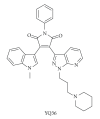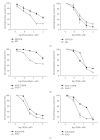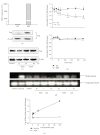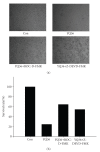YQ36: a novel bisindolylmaleimide analogue induces KB/VCR cell death
- PMID: 20069125
- PMCID: PMC2804113
- DOI: 10.1155/2009/535072
YQ36: a novel bisindolylmaleimide analogue induces KB/VCR cell death
Abstract
Overexpression of multidrug resistance proteins P-glycoprotein (P-gp, MDR1) causes resistance of the tumor cells against a variety of chemotherapeutic agents. 3-(1-methyl-1H-indol-3-yl)-1-phenyl-4-(1-(3-(piperidin-1-yl)propyl)-1H-pyrazolo[3,4-b]pyridine-3-yl)-1H-pyrrole-2,5-dione (YQ36) is a novel analogue of bisindolylmaleimide, which has been reported to overcome multidrug resistance. Here, we dedicated to investigate the anticancer activity of YQ36 on KB/VCR cells. The results revealed that YQ36 exhibited great antiproliferative activity on three parental cell lines and MDR1 overexpressed cell lines. Moreover, the hypersensitivity of YQ36 was confirmed on the base of great apoptosis induction and unaltered intracellular drug accumulation in KB/VCR cells. Further results suggested that YQ36 could not be considered as a substrate of P-gp, which contributed to its successfully escaping from the efflux mediated by P-gp. Interestingly, we observed that YQ36 could accumulate in nucleus and induce DNA damage. YQ36 could also induce the activation of caspase-3, imposing effects on the mitochondrial function. Collectively, our data demonstrated that YQ36 exhibited potent activities against MDR cells, inducing DNA damage and triggering subsequent apoptosis via mitochondrial pathway.
Figures






Similar articles
-
Effects of the selective bisindolylmaleimide protein kinase C inhibitor GF 109203X on P-glycoprotein-mediated multidrug resistance.Br J Cancer. 1996 Sep;74(6):897-905. doi: 10.1038/bjc.1996.454. Br J Cancer. 1996. PMID: 8826855 Free PMC article.
-
Reversal of P-glycoprotein-mediated multidrug resistance in SGC7901/VCR cells by PPARgamma activation by troglitazone.J Huazhong Univ Sci Technolog Med Sci. 2010 Jun;30(3):326-31. doi: 10.1007/s11596-010-0351-6. Epub 2010 Jun 17. J Huazhong Univ Sci Technolog Med Sci. 2010. PMID: 20556576
-
Pyramidatine (Z88) Sensitizes Vincristine-Resistant Human Oral Cancer (KB/VCR) Cells to Chemotherapeutic Agents by Inhibition of P-glycoprotein.Anticancer Agents Med Chem. 2018;18(2):286-294. doi: 10.2174/1871520617666170803155025. Anticancer Agents Med Chem. 2018. PMID: 28782465
-
5-(3,4,5-trimethoxybenzoyl)-4-methyl-2-(p-tolyl) imidazol (BZML) targets tubulin and DNA to induce anticancer activity and overcome multidrug resistance in colorectal cancer cells.Chem Biol Interact. 2020 Jan 5;315:108886. doi: 10.1016/j.cbi.2019.108886. Epub 2019 Nov 1. Chem Biol Interact. 2020. PMID: 31682804
-
Glabridin resensitizes p-glycoprotein-overexpressing multidrug-resistant cancer cells to conventional chemotherapeutic agents.Eur J Pharmacol. 2019 Jun 5;852:231-243. doi: 10.1016/j.ejphar.2019.04.002. Epub 2019 Apr 5. Eur J Pharmacol. 2019. PMID: 30959046
References
-
- Ambudkar SV, Dey S, Hrycyna CA, Ramachandra M, Pastan I, Gottesman MM. Biochemical, cellular, and pharmacological aspects of the multidrug transporter. Annual Review of Pharmacology and Toxicology. 1999;39:361–398. - PubMed
-
- Hipfner DR, Deeley RG, Cole SPC. Structural, mechanistic and clinical aspects of MRP1. Biochimica et Biophysica Acta. 1999;1461(2):359–376. - PubMed
-
- Szakács G, Paterson JK, Ludwig JA, Booth-Genthe C, Gottesman MM. Targeting multidrug resistance in cancer. Nature Reviews Drug Discovery. 2006;5(3):219–234. - PubMed
-
- Jirousek MR, Gillig JR, Gonzalez CM, et al. (S)-13-[(dimethylamino)methyl]-10,11,14,15-tetrahydro-4,9:16,2-dimetheno-1H,13H-dibenzo[e,k]pyrrolo[3,4-h][1,4,13]oxadiazacyclohexadecene- 1,3(2H)-dione (LY333531) and related analogues: isozyme selective inhibitors of protein kinase Cβ. Journal of Medicinal Chemistry. 1996;39(14):2664–2671. - PubMed
Publication types
MeSH terms
Substances
LinkOut - more resources
Full Text Sources
Research Materials
Miscellaneous

